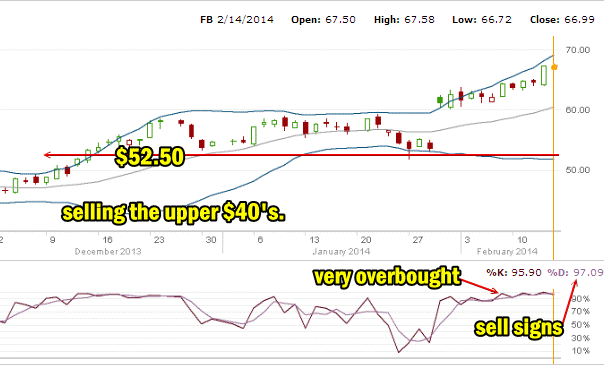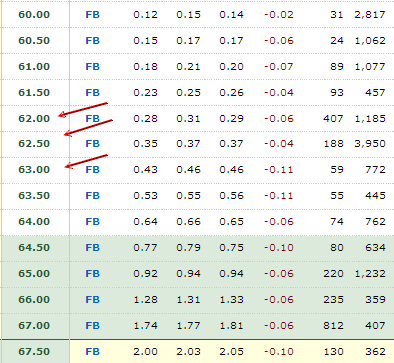The last article I wrote on Facebook Stock was in December. In it I looked at a variety of profit and income generating strategies. In 2013 I had two stocks for speculative trades which I alternated between. The first was Lululemon Stock (LULU) and the second was Facebook Stock (FB Stock). Both provided exceptional returns. By the end of the year my focus was on Facebook Stock and I was also looking at Twitter Stock (TWTR) to replace Lululemon Stock.
Facebook Stock though has a strong enough outlook that I feel it is the better choice for Put Selling. Back in mid December I was doing weekly and biweekly Put Selling on Facebook Stock. I continued that throughout the month of January.
Why I Prefer Facebook Stock
I only do one speculative trade at a time and normally I focus on two stocks and alternate between them as I did last year with Lulu Stock and FB Stock. However despite this being a speculative trade I still prefer to be trading a stock that:
- has a decent pattern
- has revenue growth
- has good fundamentals
- it must perform the way the technical indicators advise
A speculative trade does not necessarily mean I must place income above risk. In fact the opposite is true. When I do a speculative trade I place risk to my capital as the prime objective and income as second. Therefore the last requirement that it must perform the way the technical indicators advise is paramount to my success. I always do my utmost to stack the odds of success in my favor. That means a stock needs to follow my technical indicators to a very large degree. If it doesn’t and continually moves opposite to what the technical indicators advise, then it becomes simply a “gamble” or a “best guess” trade. As I do not gamble or best guess stocks there is no point in trading when the technical indicators are of little value.
Speculative Trades Are A Testing Ground
A speculative trade is not only enjoyable but it is among the best way’s to learn and test new strategies. Often a strategy that works with a speculative will work well with other less speculative stocks.
To that end, I have been focusing on the weekly put options for Facebook Stock. Part of the reason is because of the success with the Apple Stock Biweekly Put Selling Strategy. Once I saw how profitable and how easy the biweekly and weekly Put Selling within Apple Stock was, I decided to see if some of the same principles could be applied to Facebook Stock.
Facebook Stock Daily Chart December to Feb 14
If we look at the Facebook Stock from December to Feb 14 (today) one feature really stands out. In the most recent correction Facebook Stock only pulled back to support which sits at $52.50. Since December 11 I have sold in the upper 40″s for my put strikes. Returns have been quite good. However with the latest jump higher which started Jan 30 when the stock jumped from $53.53 to $61.00, I had to move higher which means moving into a range where there is little support.
At present I am in the low 60’s with my Put Selling but any kind of pull back would immediately place those puts in jeopardy of assignment and owning shares of Facebook Stock is not my goal.
You can see that the Slow Stochastic has been very overbought almost since the stock jumped higher and there are sell signs almost daily which investors continue to ignore as they push the stock higher daily.

Valuations on Facebook Stock
The valuations on Facebook Stock are too high at 102.6 times PE. Cash flow is just $1.00 and earnings are at 66 cents. Book value is just $6.07. But overall the stock is truly speculative in nature as it is the future “potential” that investors are buying here. Just like Amazon stock which trades at a mind-boggling 608.6 time price to earnings, investors believe in the future this stock will be worth a lot more. Amazon’s earnings are around 59 cents a share and their cash flow is at $7.77 a share. Therefore even with a price to cash flow Facebook is too high and a price to cash flow of 68.4 times versus Amazon’s 45.6 times. Therefore any hint of trouble or a decline in revenue and Facebook will tumble in my opinion.
Facebook Stock Needs A Strong Strategy
Therefore unlike Apple Stock, which has a well defined chart and is fairly easy to sell puts against, Facebook Stock needs a better strategy. I have been working on studying a number of different technical indicators over the course of the past year with Facebook Stock and I am preparing to put them into use. I will post that article shortly but overall I think Facebook Stock has definite trading merit. The stock has a large retail investor following as it falls outside the criteria of most fund and pension managers. This has assisted in keeping the volatility up in the stock and the put premiums decent especially for those investors interested in selling weekly puts.
A lot of stocks that trade weekly puts often have low put premiums which makes selling them not only difficult but considering the risk to capital, not very worthwhile. Stocks like Facebook are more volatile and have better premiums.
Feb 28 2014 Expiry Facebook Stock Put Premiums
For example, below are the put premiums available as of 1:40 PM on Feb 14 for two weeks risk to capital. The $63 to $62.00 puts have premiums well worth attempting to earn but only with the right strategy being used.

The Case for Put Credit Spreads
Many investors might argue that Facebook Stock is a prime example of where put credit spreads should be used. Indeed there is a definite advantage in that the short side is capped by the long put that is bought.
While it is not my favorite strategy, put credit spreads do hold merit for many investors interested in Facebook Stock. However selling the lower end of the 60’s range is not very profitable. For example looking at the put premiums chart above, the $63.00 put could be sold for .43 cents and the $62.00 bought for .31. This would create a profit of 12 cents. Personally I would not be interested in following this trade for 12 cents but the profit and protection are there.
Instead a put credit spread slightly higher probably makes more sense. For example selling the $64.50 for .77 cents and then buying the $63 for .46 to earn 31 cents. At 31 cents the risk to capital is higher at $1.50, but the return is better.
The Case for Strategy Use and Selling Puts Naked
For my trades though I still prefer the naked puts and using a strategy that allows me to judge entry and exit periods. With the put credit spread the ability to close early is hampered by the return that might be earned. For example, closing the put credit spread early might mean earning 60% or 70% of the initial 31 cents earned.
With naked puts closing the trade early for 60% or 70% often means picking up 50 or 60 cents of the initial trade and growing my portfolio faster.
Personal Preference
It comes down to personal preference. Many investors like put credit spreads as they feel a lot more confident holding protective puts and there is definitely value in that. Others such as myself who have larger amounts of capital available and who have perhaps more experience at handling downturns prefer using a strategy and attempting to capture as much put premium as possible.
Having A Tested Strategy Helps Protect My Capital
As stocks head into the upcoming spring for 2014, many stocks are poised to either move higher or if earnings disappoint, fall back. Facebook Stock is highly speculative and if earnings disappoint in the next quarter, a 10% to 20% drop would not be surprising. This is why I believe the only way to trade in speculative stocks is through having a strong strategy that can warn in advance of when weakness could be entering the trade. Stacking the odds in my favor is important when it comes to Put Selling weekly put options. Having a tested strategy to do that is key to those trades remaining successful and keeping my capital as safe as possible.
Internal Stock and Option Trades Links
Put Selling Strategies For Members
Covered Calls Strategies For Members
Profit And Income Strategies Index
Stock and Option Strategies For Members
Stock And Option Trades Explained For Members

